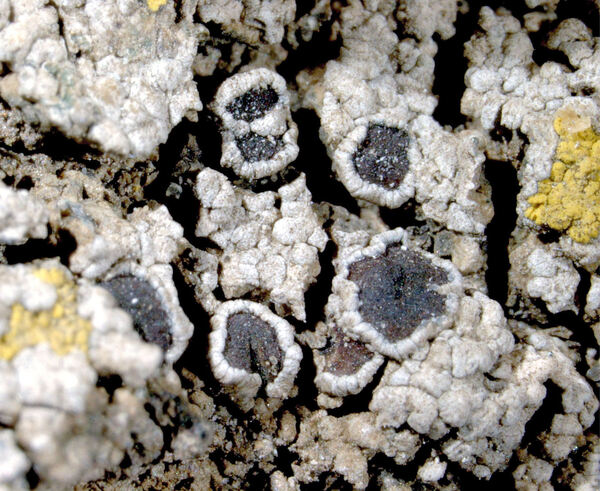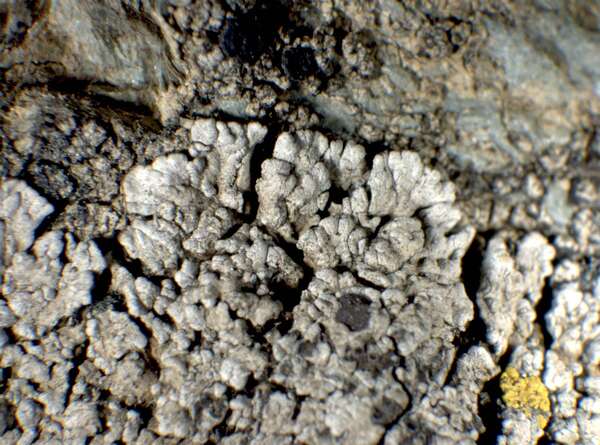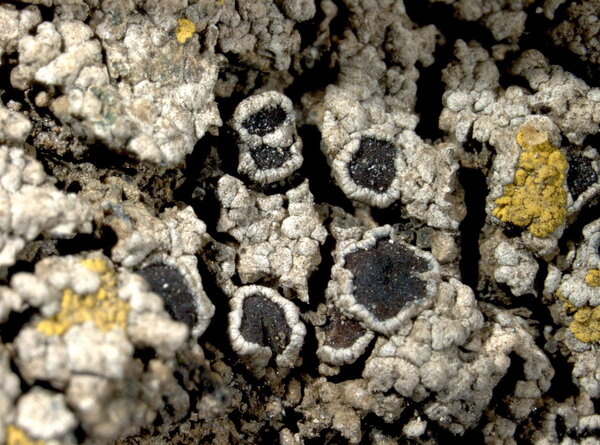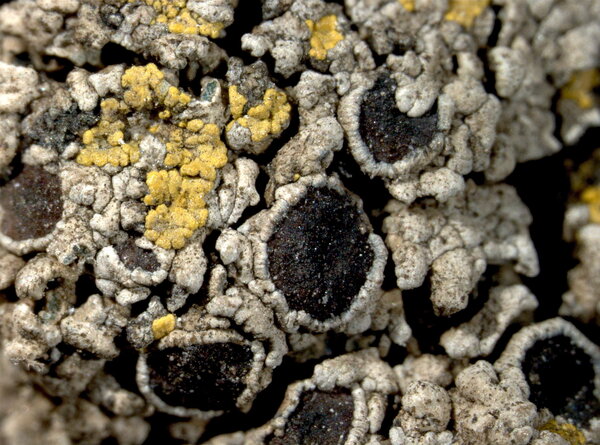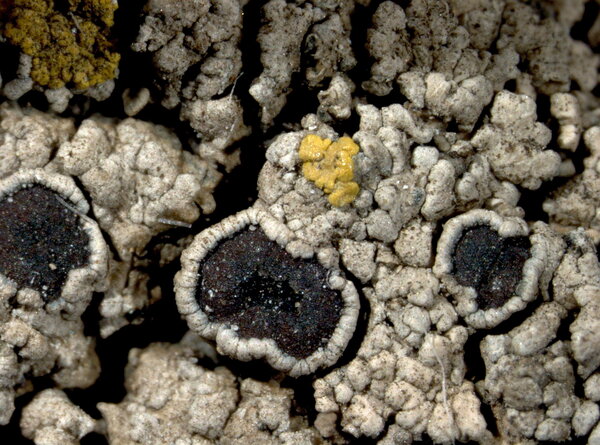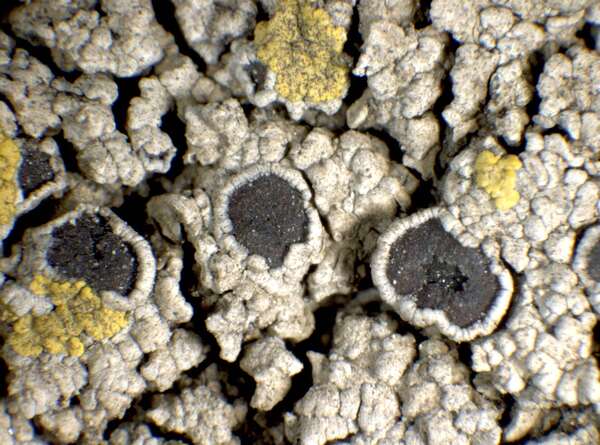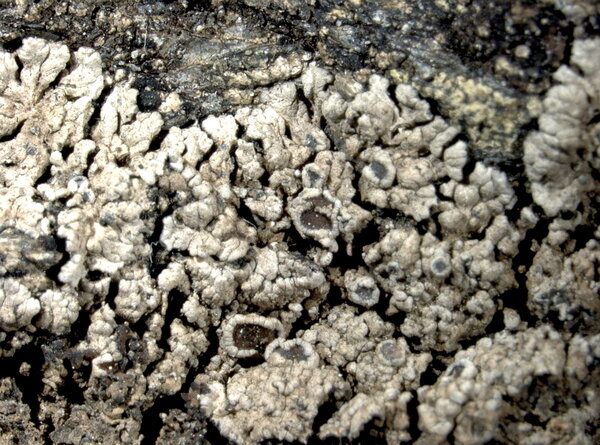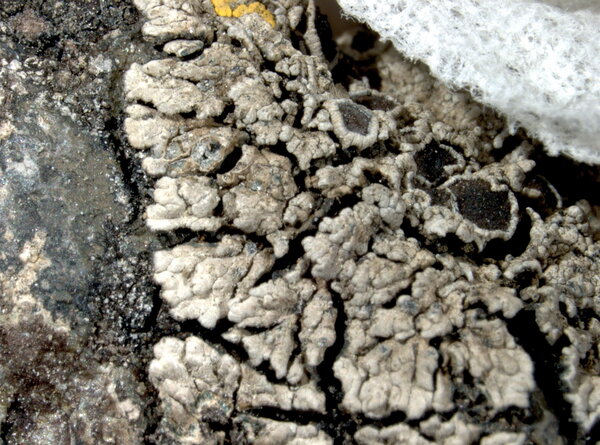Pannaria hookeri (Sm.) Nyl.
Mém. Soc. Imp. Sc. Nat. Cherbourg, 5: 109, 1858. Basionym: Lichen hookeri Borrer ex Sm. in Smith & Sowerby - English Bot., 32: 2283, 1811.
Synonyms: Pannaria glacialis Anzi; Pannaria hookeri var. macrior Th. Fr.; Pannaria leucolepis (Wahlenb.) Nyl.
Description: Thallus crustose-placodioid to subsquamulose, heteromerous, dorsiventral, forming adpressed, up to 3 cm wide rosettes developing on a black, diffuse, thin prothallus. Squamules flat to convex, 0.3-1 mm wide, dispersed to overlapping, tightly adnate or rarely loosely attached, irregularly rhomboid, delimited by deep cracks and often wart-like in thallus centre, more or less effigurate and spathulate at margins, the marginal ones to 3 mm wide and 0.2-0.3 mm thick. Upper surface pale brownish grey to bluish grey, more or less scabrid-maculate and faintly whitish-striate, especially at margins. Upper cortex paraplectenchymatous, small-celled, 40-60 μm thick; medulla white; lower cortex absent. Apothecia common, lecanorine, 0.4-1.5(-2) mm across, scattered, constricted at base, with a black or rarely black-brown, at first flat then often convex, rough disc, and a crenulate, somewhat inrolled, whitish thalline margin. Thalline exciple 80-150 μm wide; proper exciple very thin, c. 10–20 μm wide, dark brown, prosoplectenchymatous; epithecium blue-green to green-black, K+ intensifying green, N+ red; hymenium colourless or partially brown-red, (65-)70-100(-200) µm high, hemiamyloid, I+ reddish brown, K/I+ blue; paraphyses mostly simple, 1.5–2.5 μm thick at mid-level, the apical cells hardly swollen or up to 4-5 μm wide; hypothecium colourless to yellowish. Asci 8-spored (but often with a few aborted ascospores), clavate, with a well developed, non-amyloid or very weakly amyloid tholus lacking internal structures, and an intensely amyloid, thin outer sheath. Ascospores 1-celled, hyaline, broadly ellipsoid to subglobose, (10-)12-16(-18) x 6-9(-11) μm, smooth- and thick-walled. Photobiont cyanobacterial, (Nostoc, the cells in clusters). Spot tests: thallus K-, C-, KC-, P- or P+ faintly orange. Chemistry: with variable,often low amounts of pannarin.
Growth form: Squamulose
Photobiont: cyanobacteria, filamentous (e.g. Nostoc, Scytonema)
Reproductive strategy: mainly sexual
Commonnes-rarity: (info)
Alpine belt: very rare
Subalpine belt: rare
Montane belt: absent
Dry submediterranean belt: absent
Humid submediterranean belt: absent
Padanian area: absent
pH of the substrata:
1 2 3 4 5
Solar irradiation:
1 2 3 4 5
Aridity:
1 2 3 4 5
Eutrophication:
1 2 3 4 5
Poleotolerance:
0 1 2 3
Altitudinal distribution:
1 2 3 4 5 6
Rarity
absent
extremely rare
very rare
rare
rather rare
rather common
common
very common
extremely common
Loading data...
Occurrence data
Predictive map
Growth form: Squamulose
Photobiont: cyanobacteria, filamentous (e.g. Nostoc, Scytonema)
Reproductive strategy: mainly sexual
Commonnes-rarity: (info)
Alpine belt: very rare
Subalpine belt: rare
Montane belt: absent
Dry submediterranean belt: absent
Humid submediterranean belt: absent
Padanian area: absent
pH of the substrata:
| 1 | 2 | 3 | 4 | 5 |
Solar irradiation:
| 1 | 2 | 3 | 4 | 5 |
Aridity:
| 1 | 2 | 3 | 4 | 5 |
Eutrophication:
| 1 | 2 | 3 | 4 | 5 |
Poleotolerance:
| 0 | 1 | 2 | 3 |
Altitudinal distribution:
| 1 | 2 | 3 | 4 | 5 | 6 |
Rarity
absent
extremely rare
very rare
rare
rather rare
rather common
common
very common
extremely common
Loading data...
Occurrence data
Predictive map


